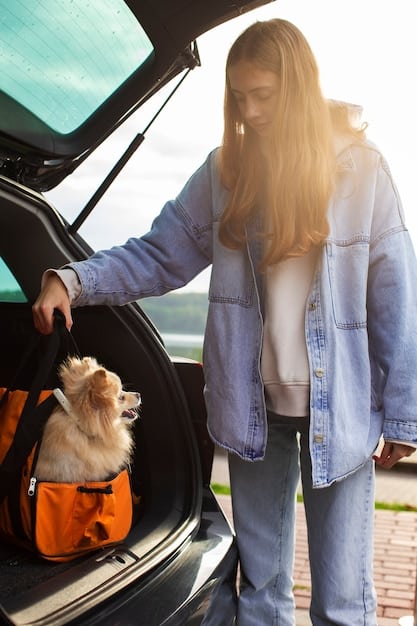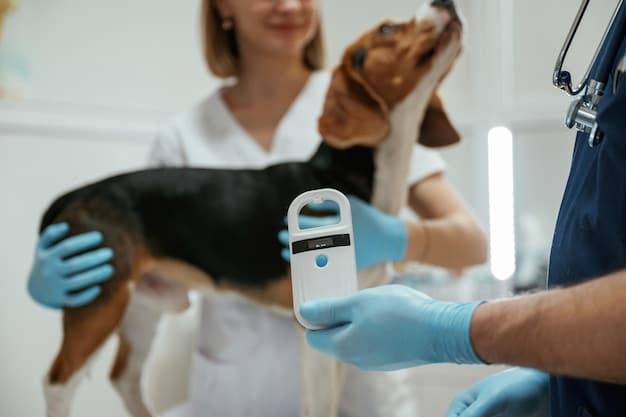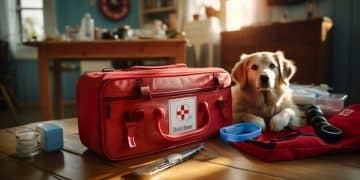Pet Disaster Plan: Hurricane & Emergency Preparedness Guide

Emergency preparedness including a pet disaster plan is crucial for ensuring the safety of your furry family members during hurricanes and other natural disasters by identifying evacuation routes, securing pet-friendly shelters, and assembling essential supplies.
Natural disasters like hurricanes can strike with little warning, making emergency preparedness: creating a pet disaster plan for hurricanes and other natural disasters essential for pet owners. This guide ensures you’re ready to protect your beloved animals when disaster strikes.
Why Pet Disaster Preparedness is Essential
Preparing for disasters is often focused on human safety, but our pets are also vulnerable and dependent on us. Having a solid disaster plan tailored to your pet’s needs can make all the difference in ensuring their safety and well-being during a crisis.
Ignoring pet disaster preparedness can lead to devastating outcomes. Evacuating without a plan can mean leaving your pets behind, facing the difficult decision of choosing your safety over theirs. A well-thought-out plan can prevent such heartbreaking scenarios.
The Risks of Not Planning
The reality of natural disasters is that they are unpredictable and can escalate rapidly. Failing to prepare for these events can expose your pets to numerous risks, including:
- Injury and Illness: Debris, floods, and other hazards can cause physical harm or lead to illness.
- Separation: Pets can become lost or separated from their owners during chaotic evacuations.
- Exposure: Weather extremes, such as heat or cold, can endanger pets left without shelter.
- Lack of Essentials: Without access to food, water, and medication, pets can suffer from deprivation.
Adequate planning mitigates these risks and significantly improves your pet’s chances of survival and recovery after a disaster.
Ultimately, disaster preparedness is about responsibility and love. It means considering your pet’s needs in advance and taking concrete steps to ensure their safety. By creating and implementing a pet disaster plan, you’re giving your furry friends the best possible chance to weather any storm.
Creating a Pet-Friendly Evacuation Plan
The cornerstone of emergency preparedness: creating a pet disaster plan for hurricanes and other natural disasters is a well-defined evacuation strategy. This involves identifying safe evacuation routes and securing pet-friendly accommodations, ensuring you and your pets have a place to go when disaster strikes.
Start by identifying primary and alternate evacuation routes from your home. Familiarize yourself with these routes in advance, and consider potential obstacles or traffic congestion. Having a clear path in mind will save valuable time during an evacuation.

Finding Pet-Friendly Shelters and Hotels
Not all shelters accept pets, so it’s crucial to identify pet-friendly options in advance. Contact local animal shelters, humane societies, or emergency management agencies to inquire about pet-friendly shelters in your area. Keep a list of these shelters readily accessible.
- Check Hotel Policies: Many hotels have restrictions on pet size, breed, or number of pets allowed. Call ahead to confirm their policies and make a reservation.
- Consider Out-of-State Options: If disaster is imminent, look for pet-friendly accommodations in neighboring states. This can provide a wider range of options.
- Use Online Resources: Websites like BringFido and Petswelcome can help you find pet-friendly hotels and accommodations in various locations.
By proactively identifying evacuation routes and pet-friendly accommodations, you can reduce stress and ensure a smoother evacuation process, keeping your pets safe and secure.
Having a solid evacuation plan ensures you have a safe place to go with your pets during a disaster.
Building a Pet Emergency Kit
Just as essential as having a plan is having the right supplies on hand. Assembling a comprehensive pet emergency kit is a critical step in emergency preparedness: creating a pet disaster plan for hurricanes and other natural disasters.
Your pet emergency kit should include everything your pet needs to survive for at least three to seven days. These supplies should be stored in a waterproof, easily portable container, such as a plastic bin or backpack.
Essential Supplies for Your Pet’s Kit
The exact contents of your pet emergency kit will vary depending on the type of pet you have, but here are some essential items to include:
- Food and Water: Pack a three- to seven-day supply of non-perishable pet food and bottled water. Consider your pet’s specific dietary needs and any medical conditions.
- Medications: Include any prescription medications your pet takes, as well as a basic pet first-aid kit with items like antiseptic wipes, bandages, and antibiotic ointment.
- Identification and Medical Records: Keep copies of your pet’s vaccination records, microchip information, and a recent photo. These can be crucial if your pet gets lost.
- Leash, Collar, and Carrier: Ensure you have a secure leash, collar with identification tags, and a sturdy pet carrier. The carrier should be large enough for your pet to stand up and turn around comfortably.
Tailoring your pet emergency kit to their specific needs ensures you’re prepared for a wide range of scenarios.
A well-stocked pet emergency kit provides peace of mind knowing you have the essentials to care for your pets during a crisis.
Microchipping and Identification: Protecting Your Pet
In the chaos of a disaster, pets can easily become lost or separated from their owners. Microchipping and proper identification are vital tools in emergency preparedness: creating a pet disaster plan for hurricanes and other natural disasters, increasing the chances of reuniting with your furry friend.
A microchip is a small, electronic chip implanted under your pet’s skin, typically between the shoulder blades. The chip contains a unique identification number that can be scanned by veterinarians or animal shelters. It’s linked to a database containing your contact information, making it possible to identify and contact you if your pet is found.

Ensuring Accurate Registration and Visible ID
While microchipping is a crucial step, it’s only effective if the information associated with the chip is accurate and up-to-date. Here are some tips for maintaining your pet’s microchip registration:
- Register the Microchip: Make sure your pet’s microchip is registered with a reputable registry service. This is often included with the microchipping procedure.
- Update Your Contact Information: If you move or change your phone number, promptly update your contact information with the registry.
- Check the Registration Annually: Set a reminder to check and update your pet’s microchip information at least once a year.
Maintaining accurate contact information ensures that you can be reached quickly if your pet is found.
Microchipping and visible identification can make the difference between a lost pet and a happy reunion.
Training and Behavior Considerations for Disaster Scenarios
A well-behaved pet is easier to manage during stressful situations. Incorporating training and behavior considerations into your emergency preparedness: creating a pet disaster plan for hurricanes and other natural disasters can significantly improve your pet’s safety and your ability to handle them effectively during a disaster.
Training your pet to respond to basic commands, such as “sit,” “stay,” and “come,” can be invaluable during an evacuation. These commands can help you control your pet in unfamiliar or chaotic environments.
Acclimating Pets to Carriers and Travel
Many pets are fearful of carriers or unfamiliar with car travel. Make the carrier a positive and familiar space for your pet.
- Introduce the Carrier Gradually: Leave the carrier out in a common area with the door open. Place treats or toys inside to encourage your pet to enter.
- Positive Reinforcement: Reward your pet with praise and treats each time they enter the carrier.
- Short Car Rides: Start with short car rides around the block and gradually increase the duration. This helps your pet become accustomed to travel.
Training can facilitate smoother evacuations, enabling you to manage your pets more effectively.
A prepared and well-behaved pet is safer and easier to manage during a disaster.
Community and Collaboration in Pet Disaster Preparedness
Disaster preparedness isn’t something you have to do alone. Engaging with your community and collaborating with neighbors can significantly enhance your emergency preparedness: creating a pet disaster plan for hurricanes and other natural disasters.
Building a network of trusted neighbors, friends, and family members who can assist you in an emergency can be a lifesaver. Share your pet disaster plan with them and discuss how you can support each other in a crisis.
Forming a Pet Disaster Support Network
Here are some actions to consider:
- Share Contact Information: Exchange contact information with neighbors and identify individuals who are willing to help with pet care in an emergency.
- Buddy System: Create a buddy system where neighbors agree to check on each other’s pets if one household is away during a disaster.
- Emergency Pet Care Agreements: Formalize agreements with trusted individuals who can temporarily care for your pets if you are unable to do so.
By working together, you increase the safety and support network available to your pets during a disaster,.
Community collaboration can dramatically enhance the safety and well-being of pets during a disaster.
| Key Point | Brief Description |
|---|---|
| ⚠️ Evacuation Plan | Identify safe routes and pet-friendly shelters/hotels in advance. |
| 🎒 Emergency Kit | Prepare a kit with food, water, meds, ID, leash, and carrier. |
| 🆔 Microchipping & ID | Ensure your pet is microchipped and ID tags are up to date. |
| 🐾 Training & Behavior | Train your pet for commands and acclimation to carriers/travel. |
Frequently Asked Questions (FAQ)
Contact local animal shelters or humane societies for assistance. Coordinate with trusted friends or family to care for them temporarily. Never leave pets behind, as they are unlikely to survive on their own.
Check the expiration dates on food and medications at least twice a year, and replace them as needed. Also, review and update the kit’s contents to reflect any changes in your pet’s needs.
Speak to your pet in a calm, reassuring voice. Provide them with a safe and familiar space, like their carrier or a quiet room. Using calming aids, such as pheromone sprays, might also help.
Immediately contact local animal shelters, veterinary clinics, and emergency response teams. Post flyers with your pet’s photo and description in the affected area and on social media. Check your pet’s microchip registration is accurate.
Some organizations offer assistance to low-income pet owners for disaster preparedness. Contact local animal welfare groups and charities for programs that help with pet food, vaccinations, and emergency boarding.
Conclusion
Taking the steps to prepare for disasters provides peace of mind, knowing you have done all you can to protect your beloved companions. By creating a comprehensive plan, assembling an emergency kit, and microchipping your pets, you’re significantly increasing their chances of weathering any storm.





